Menu

Did you know that breaking UK’s hazardous waste rules can cost you up to £5,000? This big fine shows how key it is to know and follow the rules in the Hazardous Waste (England and Wales) Regulations 2005. They have 12 parts and 78 subsections and have been around since July 16, 2005. These rules help keep people and the environment safe. The Waste (England and Wales) Regulations 2011 showed a new way to think about waste. Now it’s all about stopping waste before it starts, then reusing, and recycling it, before any disposal is even considered.
In Britain, there are tough laws for handling dangerous waste. If your business deals with hazardous stuff like asbestos, batteries, or some oils, you must be very careful. You should keep all waste records for three years. This makes sure you are ready if anything unexpected happens. Keeping good records is as important as the waste itself.
These rules cover all of the UK, including England, Northern Ireland, Scotland, and Wales. They also say how waste can be exported. A company like Asbestos Boss Limited had to pay £80,000 for mismanaging asbestos. This story shows why it’s so important to do things right. If you don’t, the fine could be huge, but that’s not all. It could also stop your work, lead to tough lawsuits, and hurt your business’s name and money.
The new UK hazardous waste management regulations are a big step for protecting people and nature from hazardous waste dangers. They cover every step from making, keeping, moving, to getting rid of hazardous waste. It’s key to identify and categorise dangerous waste correctly. This helps in handling it right and following new laws.
The goal of the updated waste management regulations UK is to lower the threat of hazardous waste. Laws like The Hazardous Waste Regulations for parts of the UK set out these changes. They apply across the UK, aiming for a united effort with room for local changes.
The UK hazardous waste management regulations saw critical updates. One major change is the need for those who receive or dispose of hazardous waste in England, Wales, and Scotland to report on it every quarter. Parties should follow a step-by-step guide for managing this waste, placing emphasis on prevention and reuse.
This includes changes such as The Hazardous Waste (Amendment) Regulations (Northern Ireland) 2005 and The Hazardous Waste (Miscellaneous Amendments) (Wales) Regulations 2018. These show how the rules keep evolving for a better environment. National rules like the Special Waste Regulations make sure everyone follows specific standards.
Although some rules, like stopping premises registration in England, make things easier, the focus is still on doing things the right way. The aim is to avoid the heavy penalties of not following the law. Everyone must stick to these waste management regulations UK. This means using the proper waste order and keeping good records for full environmental protection.
Handling hazardous waste in the UK is vital for protecting our environment and health. Those who make or keep hazardous waste have big jobs. They need to follow laws closely to keep everyone safe.
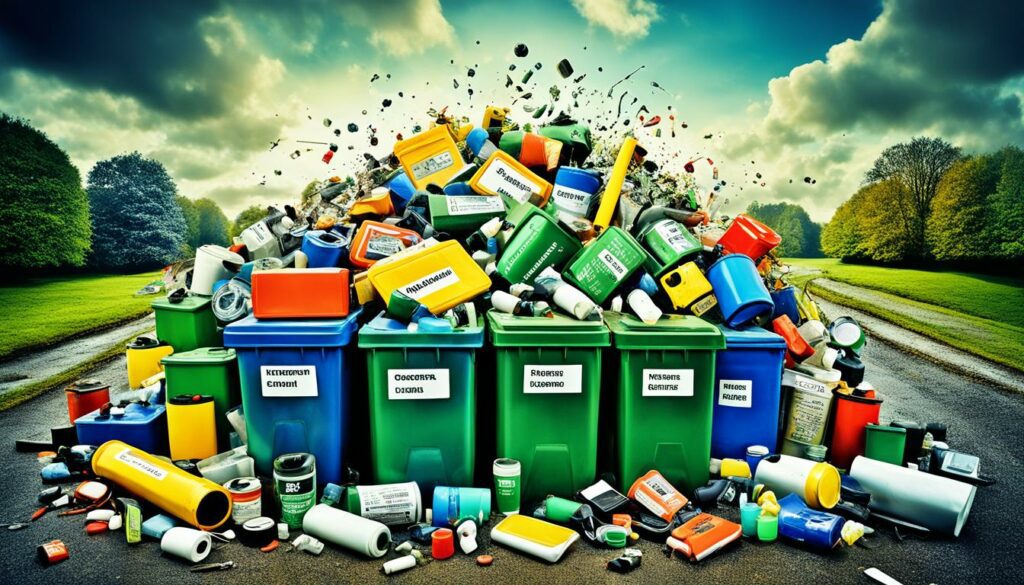
In the UK, many businesses and places can make hazardous waste. Think of labs with chemicals, car shops with used oil, and stores selling batteries. These places must keep their hazardous waste separate and tell the Environment Agency if they make over 500kg each year. This way, the UK ensures dangerous waste is handled safely, reducing harm to people and nature.
If you keep or control hazardous waste, you’re a waste holder. Your main job is to make sure this waste is gotten rid of safely, so it doesn’t hurt anyone. You should store it in the right containers and keep it away from other waste. Each time it’s taken away, a special note must go with it. This note says what the waste is and where it’s going. Doing these things is key to staying on the right side of the law and making sure hazardous waste in the UK is dealt with well.
Not following the Hazardous Waste Regulations can result in big fines, sometimes up to £5,000. That’s a lot. This is why it’s so important for both waste makers and holders to stick to the rules. By doing so, they help keep the environment safe for everyone.
Carriers of hazardous waste play a big part in keeping our environmental compliance UK strong. They must follow strict rules to avoid any spills or leaks.
The Hazardous Waste Regulations of 2005 are now in effect. They have many rules, spread over 12 sections. The goal is to ensure hazardous waste is handled and moved safely. If these rules aren’t followed, there are fines of up to £5,000.
If a business makes more than 500kg of hazardous waste each year, they must tell the Environment Agency. This might mean they need to register as a hazardous waste site. Those who move the waste must keep very good paperwork. This helps track the waste from start to finish.
Having detailed paperwork and tracking is important. It lets us know where the hazardous waste goes. This makes sure people are following the rules well. The departments for the Environment, Food, and the Welsh Government support these steps. They help show that we handle hazardous waste properly.
The Code is admissible as evidence in legal proceedings regarding duty of care offences, highlighting the importance of maintaining strict compliance.
Those dealing with hazardous waste must take care. They are under legal duty to ensure safe collection and transport. This isn’t just a rule—it’s key in protecting our environment. By following strict and clear rules, we help keep our planet safe.
In the UK, people or companies that get waste for recycling or throwing away are called consignees. They play a big part in making sure waste is handled properly. They have to follow strict rules to manage waste right, as per UK waste laws.
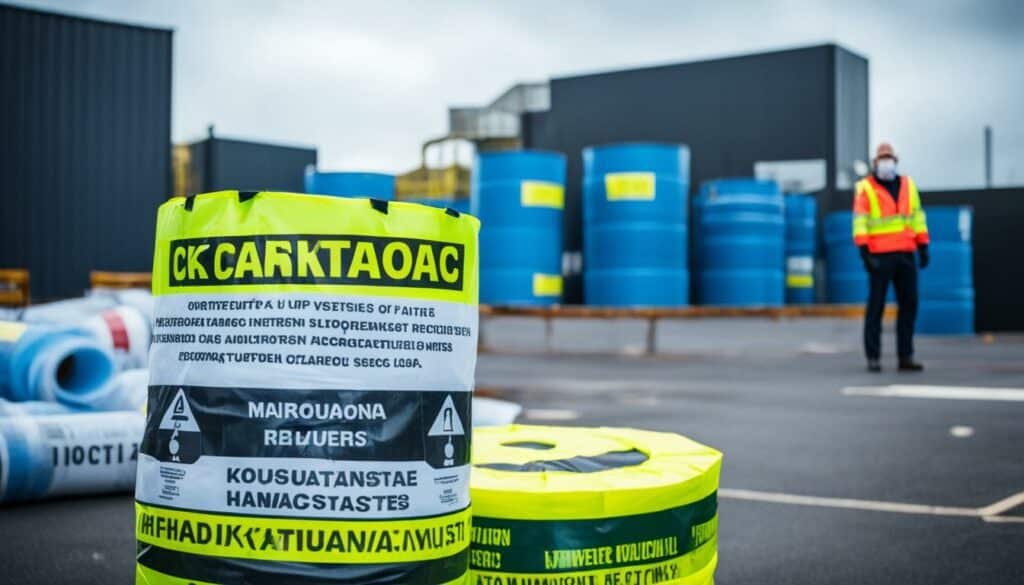
Consignees need to fill in a detailed note called the consignment note. It has five parts. The waste maker fills in Part A and B. The mover fills in Part C, checking the other parts. The note’s code is ‘XXXXXX/YYYYY’ to track it easily. It also has SIC codes for what made the waste. Part B3 describes the waste, with codes and key details like how much, what’s in it, and dangers.
If you’re a household, a person in healthcare, a tradesperson, or a roadside helper, you may handle harmful waste. As a consignee, you have to collect and deal with all types of waste carefully.
Consignees must stick to UK rules on managing harmful waste. They need to keep good records. Sites with permits keep notes on waste for five years. They store other records until their permit ends. Sites with special permission keep records for three years. These records show the weight, descriptions, and dangers of the waste sent.
Having a record of all waste on site is a must. For dumped waste, notes must match the site’s plan. For other waste handling, a plan or table linking where the waste is and what’s done with it is crucial.
Consignees need to check waste handling meets all rules. They must keep all papers linked to the waste, including carrier info and refused waste. Good records and following the rules help them manage waste safely and right.
Consignment notes are vital for safely moving hazardous waste in the UK. They are a must under UK waste laws for any hazardous waste trips. This helps keep a strong track of the movement.
Each consignment note has five parts (A to E) that need completing. This should be done before moving the waste. Here’s what these parts cover:
A consignment note is needed for every risky waste move. This rule applies even if it’s within the same company, or moving from a customer’s place. Having all these details makes the process clear and accountable.
In Wales, following the hazardous waste guidance UK means a consignment note for each move is a must. Completing each part carefully is very important. It makes sure we follow the rules and protect the environment.
These notes are also key for tracing hazardous waste. They make sure everyone handling the waste has a full, open record of its path. This helps avoid problems like bad handling or illegal dumping.
In the UK, waste management rules ask consignees to submit returns showing the hazardous waste they’ve gotten. This is to make sure they follow UK environmental laws and keep correct records. It’s for checking how the waste has been handled.
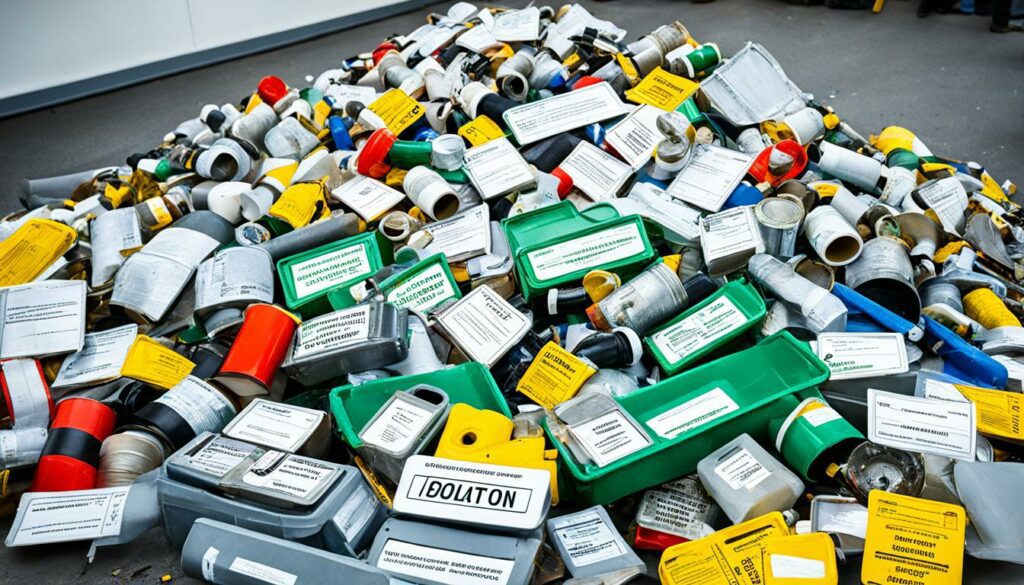
Consignees need to fill in a spreadsheet tool step by step. They start by adding their own details. Then, they make the return file. It’s important not to make common mistakes like using the wrong units for amounts or wrong addresses.
Some waste types need less detailed returns. This saves money and makes reporting simpler. If waste comes from Wales, it’s like receiving it from England. But, waste from Scotland and Northern Ireland needs a different code set.
If a place can manage different types of hazardous waste, it has special rules to follow. They must send in their returns every three months. These are the times and dates they must send them by:
| Quarter | Reporting Period | Submission Deadline |
|---|---|---|
| Q1 | 01 January – 31 March | 30 April |
| Q2 | 01 April – 30 June | 31 July |
| Q3 | 01 July – 30 September | 31 October |
| Q4 | 01 October – 31 December | 31 January |
Even if no waste is handled, they must keep records for six years. This includes filing a ‘nil return’ if no waste is received. Reports go to an email or address given by regulators. Charges for sending these reports differ if done online or by paper.
To make sure the UK protects its environment, rules allow simplified reporting for some waste types. This helps with reusing waste. Eleven types of waste like fluorescent tubes, lead-acid batteries, and certain pesticides get this benefit.
If you work with hazardous waste in the UK, you know it’s tricky. The Environment Agency is here to help. They offer support to make sure you follow the latest rules.
The Environment Agency gives lots of help to businesses dealing with hazardous waste UK. They have guides and support to explain what the rules mean. This is useful for any business that makes, moves, or disposes of hazardous waste.
The Hazardous Waste Regulations (Northern Ireland) 2005 outline how to manage and get rid of hazardous waste. They cover things like asbestos, clinical waste, and more. The rules are there to protect people and the planet.
These rules include a note system to track hazardous waste. This system uses special codes. It keeps hazardous waste safe and makes sure it’s handled correctly. The cost for these notes can be £24, £10, or they’re sometimes free.
The Environment Agency also makes rules about mixing different wastes. They check that waste sites keep good records. Plus, they do surprise visits to check everything is right. Breaking these rules can lead to big fines. It shows the importance of following the rules.
If you need more help or need to notify before you move hazardous waste, contact the Agency. You can call at 028 9056 9710, send a fax at 028 9056 9310, or email at hazwaste@daera-ni.gov.uk. Their advice keeps you on the right track, protecting both people and environments.
Implementing the UK hazardous waste management regulations is key. It keeps the environment safe and protects public health. These rules help businesses and people manage hazardous waste well. Let’s explore these rules and discover what hazardous waste is.
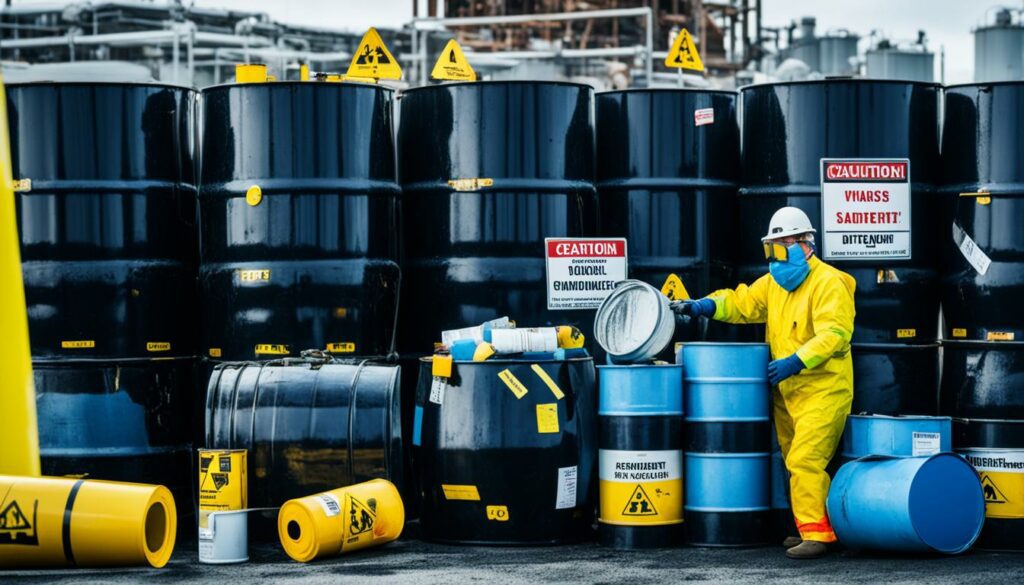
Hazardous waste is a danger to people and the planet. In 2018, the UK created 222.2 million tonnes of waste, a lot being hazardous. This waste can be solid, liquid, or gas. It can burn, explode, eat away things, or be toxic. Grouping it into types helps handle it right under the UK hazardous waste management regulations.
| Type | Examples |
|---|---|
| Always Hazardous | Asbestos, batteries, certain oils |
| Needs Assessing | Chemicals, clinical waste |
| Never Hazardous | Non-toxic plastics, paper wastes |
Different hazardous wastes, like adhesives and radioactive materials, must be handled carefully. Each year, England gets rid of over 5.3 million tonnes of this type of waste. Businesses with a lot of hazardous waste must follow the hazardous waste guidance UK. This ensures their waste is managed well, from tracking to treatment.
The UK strictly controls hazardous waste exports. The rules fall under the Waste Shipments Regulation EC No 1013/2006, with extra details in The International Waste Shipments (Amendment) (EU Exit) Regulations 2019. These rules aim to ensure the UK meets its environmental compliance UK obligations, keeping people and the planet safe.
These laws make it clear what waste can’t be sent out. Any shipment must follow either the amber or the green list controls. Which one to use depends on the waste type, the treatment it needs, the destination, and how it gets there.
Exporting and importing waste means following strict rules. Whether by road, rail, air, or sea, the waste legislation UK requires exporters to report the journey details. This reporting happens through the International Waste Shipments (IWS) online service.
Applying to export waste takes time and careful planning. The whole process, from describing the waste to its travel route, can take months. Exporters need to stick to set deadlines. They should be ready for possible route changes and know that they’ll have to pay a fee for each application.
Since September 2021, UK rules on waste shipping have been updated. The new focus is on full protection of the environment. This move is to support the countryside, sustainable farming, and fishing. It also makes sure the UK keeps up with international waste agreements like the Basel Convention and the OECD Decision.
There are strict rules on sending waste for disposal. Most of the time, it’s not allowed unless in special cases. These cases include emergencies and testing new treatment methods. Waste that’s radioactive or contains mercury has its own set of transport and disposal rules. This adds to the environmental compliance UK.
For a successful waste export, getting permission from all relevant authorities beforehand is a must. Following these steps helps make the environment, both at home and globally, safer and cleaner.
Getting hazardous waste classification right in the UK is very important. It helps us follow the UK’s laws on waste. These laws make sure we handle and manage waste correctly and safely.
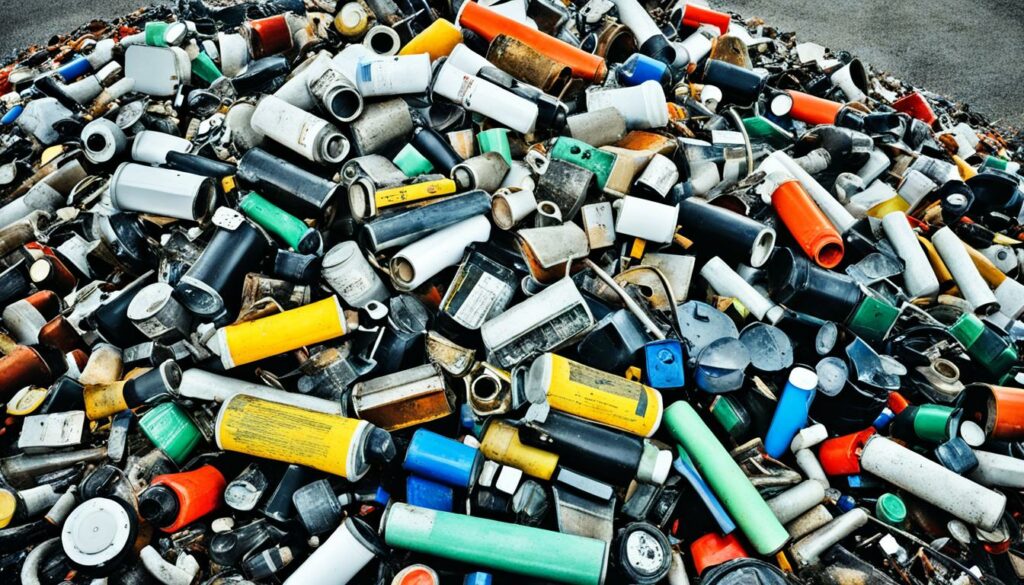
Different types of waste need different checks to classify them. For example, some waste may have more than one type of hazard. In these cases, looking at product safety data sheets from the makers can help a lot.
When moving waste, we must list what it is and where it came from. This helps track the waste through its journey. It makes sure we know who is responsible for it at each step.
Special care is needed for hazardous waste or those with POPs. It’s against the law to mix these with regular, non-hazardous waste. Even non-hazardous waste needs to be stored correctly, according to its type.
Waste managers are crucial in making sure waste is handled right. They must follow the rules carefully. This way, we protect our environment and everyone’s health by keeping up with the law.
For more in-depth instructions on classifying waste, visit the government’s advice.
The Environment Act 2021 marks the start of a new era for UK environmental rules. This big law, since its introduction in November 2021, lets the government make rules like improving air and water quality. It also aims to protect nature and cut waste. The Office for Environmental Protection (OEP) is key. It makes sure everyone follows the rules and keeps UK standards high after leaving the EU.
This law pays special attention to managing waste. It looks at how we deal with food waste to lessen harm to our planet.
The Act gives food waste a big role, knowing it’s bad for the environment. It tells businesses to handle and track their food waste responsibly. This ensures they treat it in a safe way for our earth.
One rule is to separate food waste from other rubbish. Doing this makes it easier to recycle or compost. It helps meet the government’s aims of cutting waste and handling it better.
The law also tells businesses not to use some bad ways to get rid of waste. They must find nicer, green alternatives. Now, let’s see how this works in real life:
| Action | Requirement |
|---|---|
| Segregation | Mandatory separation of food waste from other waste |
| Documentation | Detailed records of food waste generation |
| Prohibited Disposal | Bans on specific, environmentally harmful disposal methods |
| Waste Reduction Targets | Measures to achieve set reduction goals by 2050 |
When businesses follow these rules, they help the UK meet its environmental goals. It also makes our future more sustainable for everyone.
The UK has set new rules to handle Persistent Organic Pollutants (POPs). These are meant to protect both people and the environment. The rules require everyone to dispose of harmful waste properly.
Persistent Organic Pollutants (POPs) are dangerous, long-lasting chemicals. They include Polychlorinated Biphenyls (PCBs) and DDT. Waste with POPs must go to special treatment sites under the new rules. This ensures the UK keeps its hazardous waste management in check.
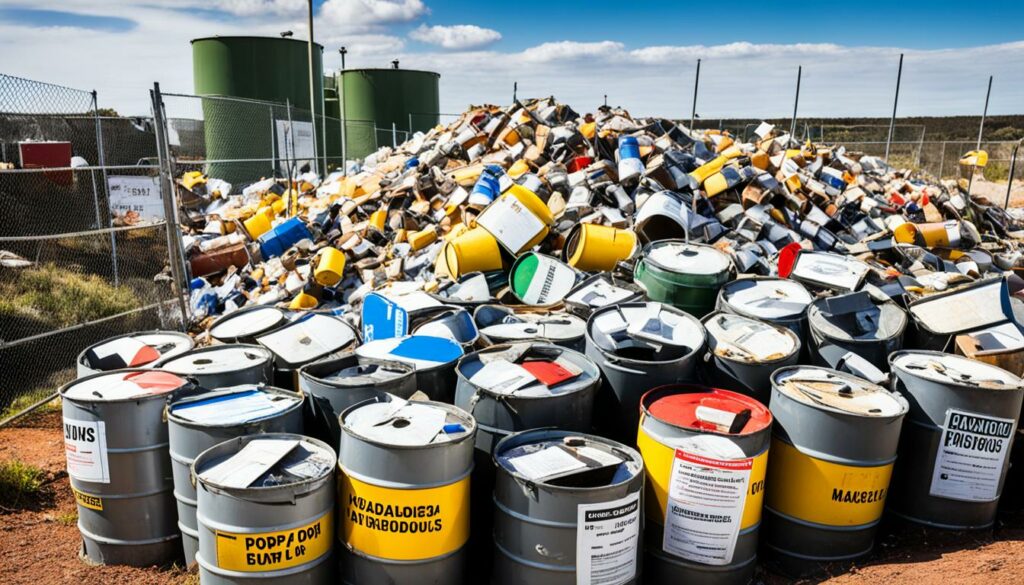
The new laws focus on furniture with foam. Items like sofas and office chairs can have POPs in them. To stop these pollutants from spreading, the law says to burn them. This way, the UK follows strict rules for getting rid of hazardous waste.
| Type of POP | Concentration Limit |
|---|---|
| Aldrin | 50mg/kg |
| Short-chain chlorinated paraffins (SCCPs) | 10,000mg/kg |
| Hexachlorocyclododecane | 1,000mg/kg |
| PCBs | 50mg/kg |
| PFOS | 50mg/kg |
Following the hazardous waste rules is key. This is vital for everyone involved, including those who handle the waste. The Environment Agency makes sure these rules are followed. This helps keep the environment and people safe.
New rules about wood waste are now in place. This affects businesses in building and tearing down structures. The new rules say that wood waste is now seen as hazardous. This means firms need to be very careful in how they deal with it. They have to follow strict rules to make sure they’re doing things right under the updated waste management regulations UK.
On August 31, 2023, things changed for construction and demolition work. A special rule called RPS 250 allowed some risky wood waste to be seen as not risky. But now, almost all wood waste in the UK is viewed as hazardous. This includes wood from very old structures and certain types of Grade D wood waste. Testing to check if wood waste is hazardous is a must now. So, sticking to the right hazardous waste guidance UK is very important.
Now, without RPS 250, wood waste from buildings made before 2007 is seen as risky until tests show otherwise. This means the job of managing this waste has become tougher. Sites that deal with this waste must have the correct licences. They also need to use the right codes when categorising the waste. Following the waste management regulations UK and hazardous waste guidance UK is crucial. It’s to avoid issues that could harm the environment or people.
Companies also need to keep all the paperwork about the waste for at least three years. This helps with tracking and checking that the rules are being followed. Agencies like the Environment Agency (EA) can look at these documents to make sure everything is okay.
In short, the construction and demolition sectors must be ready for these new, strict requirements. Dealing with hazardous wood waste properly is a big deal now. It’s not only about how they run their businesses. It shows their care for the environment and people’s safety too.
The UK takes hazardous waste management seriously, aiming to protect the environment and people. Laws like The Hazardous Waste Regulations of 2005 and The Waste (England and Wales) Regulations of 2011 set clear rules for handling and disposing of dangerous substances. They help the UK stay green and safe.
Organisations like The Environment Agency (EA) and Natural Resources Wales (NRW) make sure companies follow these laws. They ensure hazardous waste is handled safely. This prevents harm to the environment and risks to public health.
Managing hazardous waste well stops soil, water, and air from getting polluted. It’s crucial for things like asbestos, batteries, and pesticides. If not done right, companies can face big fines, like Asbestos Boss Limited, which had to pay £80,000 for mishandling asbestos.
Companies handling lots of hazardous waste must register and use special notes for tracking waste. Keeping an eye on current regulations helps avoid trouble and keeps the environment healthier. Following these laws is key to preserving our planet and keeping people safe.
The new rules are all about making us safer. They look after our health and the world around us. By making sure dangerous waste is dealt with carefully, these laws stop bad stuff from hurting us.
If a business makes or keeps dangerous waste, it’s a waste producer. This covers companies that handle things like asbestos, batteries, and some oils. They have to manage this waste safely.
Those with waste in their hands must be very careful. They need to stop harm to nature and people. Keeping good records and using the right methods for getting rid of the waste is a must.
Waste carriers carry dangerous waste without letting it leak out. They must keep detailed records, making sure they know where the waste comes from and goes. This helps track the waste’s journey.
Consignees have a big book of rules to follow when they get dangerous waste. They must keep good reports, check they meet the law, and work safely. Keeping track of everything is key.
These notes travel with hazardous waste. They say exactly what the waste is, how much there is, and how to handle it safely. Using these notes helps keep the waste process clear and safe.
Consignees must keep record of everything they get. They record what waste it was and what they did with it. This makes sure they follow all the rules.
The Environment Agency offers lots of help to understand and follow the new rules. They have guides and support for anyone who needs it. They are there to help everyone obey the law.
Dangerous waste harms nature or us. Things like solvents, pesticides, and oils are very risky. Knowing what is hazardous is critical to obeying the new laws.
The export rules demand safe treatment of dangerous waste. This stops other countries from getting hurt. Following these rules is key to sending waste legally.
An easy-to-follow system helps pick out harmful waste. This system guides waste handlers to manage each type properly. It’s essential for sticking to the rules.
This new act changes how we deal with food waste. It says we must separate food waste, ban certain ways of disposing, and keep good records. These steps help the planet.
POPs are bad chemicals so we need to burn certain furniture to keep these chemicals out of the environment and landfills. It’s a new rule to protect us and our planet.
Wood waste rules have been updated. Now, wood must be tested for danger and disposed of safely. This keeps the environment and us safe.